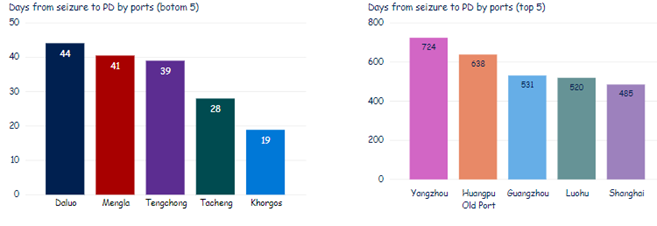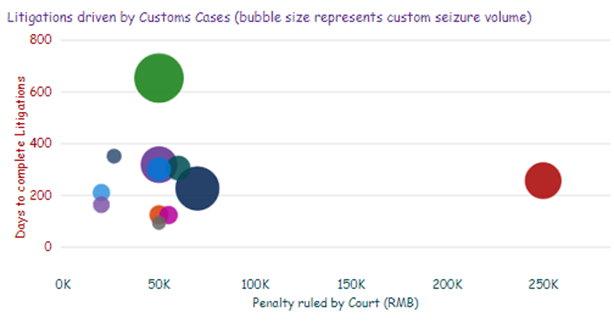IP managers want to get the best from customs seizures in China. The question is how?
Generally, they will have to wait for the procedural to provide a punishment decision (PD) to administer punishment to the infringer.
The IP holder must pay administrative costs such as warehouse and destruction. We analysed 4,600+ PDs downloaded from China Customs websites and found an average of 228 days was needed to complete the process, which means at least a part-year rental fee for a bonded warehouse will be billed to IP holders.

*Source: Punishment Decisions declared by China Customs, Rouse Analysis
In exceptional circumstances you may consider a litigation, which is not always cost-effective. We retrieved a dozen court judgments of civil litigations driven by customs seizures in China and found on average, 261 days were needed to finish a proceeding (see below). It can easily take more than one year to eventually get the compensation money, which might lead to cash flow issues.

*Source: Court Judgments declared by Supreme People’s Court, Rouse Analysis

*From customs seizure thru to court decision, with projected timeline
Is there anything else we can do? If you’re looking for something viable, risk free and almost cost-neutral, consider the opportunity to claim damages from the infringer.
The ‘damage claim’ approach works like a simplified compensation settlement. The idea is to speak to the infringers, exploit their vulnerability to civil litigation, and seek an offset compensation. Chances are the exporter would agree to compensate properly, hoping to avert the risk of civil liabilities.
We have helped many of the world’s leading brands by using this damage claim approach. Here are some of the questions we worked through during the practices.
A starter question – do infringers view lawsuit as a real threat?
Not until recently.
Historically, very little was known about court decisions throughout China. If nobody were to discover the wrongdoing anyway, getting sued did little to jeopardise their business relationship. The fine was hard to impose, and the amount wasn’t impressive in any case. It doesn’t take long for the exporter to realise how costly it is to start a litigation. Therefore, when an IP owner / agent comes seeking cash recovery in private, the odds-on answer would be ‘see you in court’ (if they answered at all).
As we observe China’s upwards IP protection trajectory, we see an upsurge in law enforcement transparency since the second half of 2018. As the Supreme Court public database becomes more sophisticated, court orders are starting to make business sense, amplified by the fact that the credit information agencies have sprung up like mushrooms. Since it’s extremely easy to check up on a company’s credibility profile using mobile apps and almost every businessperson would do that before risking investment, infringers will have to seriously care about the consequence now.
And the ‘List of Dishonest Judgment Debtors’ puts spin on the ball. Once blacklisted, a person is virtually left paralysed in China - not being allowed to get on a train nor check in to a hotel. The implementation of the blacklist effectively solved the most maligned enforceability problem.
As China’s high level of developmental velocity continues, infringers are now much more exposed to the threat of litigation, and therefore more likely to falter come damage claim negotiation time.
What is the legal basis for the claim? What else does it take to win?
On the whole, as written in the Trademark Law as well as the Regulations on the Customs IPR Protection, the ‘storage and disposal costs’ (of infringing goods) are defined as ‘reasonable expenses incurred to stop infringement’, payable by the losing party of the trial to come. But the law doesn’t specify how much. That part of spending forms the basis of the damage to claim.
Despite legal advantages in hand, it requires preparation ahead of time - careful selection of targets and understanding who we are talking to. We need profound expertise and experience about Customs IPR matters during the damage claim negotiation. Having great conversation skills is particularly helpful.
How much should I claim?
We suggest starting from RMB 10,000 – 30,000, according to experience.
The claim amount relies on the seizure value, length of storage time and how resourceful the exporter is. There are many other factors that might affect the range such as jurisdictions and skills of negotiation.
When the stars align, we could notch up phenomenal success. Imagine if the exporters are preparing for listing, they will pay whatever price it takes to avoid being sued. In our trophy room the record ceiling was RMB 500,000.
What’s the risk?
The biggest concern is we might upset Customs as we seem to be meddling with their affairs.
That’s unlikely to happen, as the damage claim is set apart from the official Customs files. Customs would continue the punishment decision anyway as in normal cases, with or without private damage claim.

*Adopting private damage claim in parallel with admin procedural
But having fewer risks doesn’t mean we can just muddle through it. We must truly understand whether the Customs are happy with private settlement and be assured that we are not ‘rocking the boat’. Therefore, it’s imperative to have a high level of familiarity with a diverse array of Customs officials.
Some ports in China are rather agile in encouraging IP holders to lawfully seek compensation settlement. Nansha Port of Guangdong Province, for example, has recently set up a special Mediation Center to explore new non-lawsuit ways to settle IP disputes. The officers have been placed under workload pressure and are happy to receive help from professionals.
What unexpected factor could increase claim value?
Climate Change.
We see the rise of environmental protection criteria almost everywhere. The ‘reasonable expense of disposal’, as mentioned before, could increase by 300% - 1,000% due to higher environmental costs. The value of a claim goes up when enforcement costs hike.
In conclusion, a damage claim is an effective option to follow a customs seizure, because it is actionable, flexible and cost-effective. The opportunity for China to neutralise enforcement costs through the non-lawsuit path is here. Are you and your team en route?